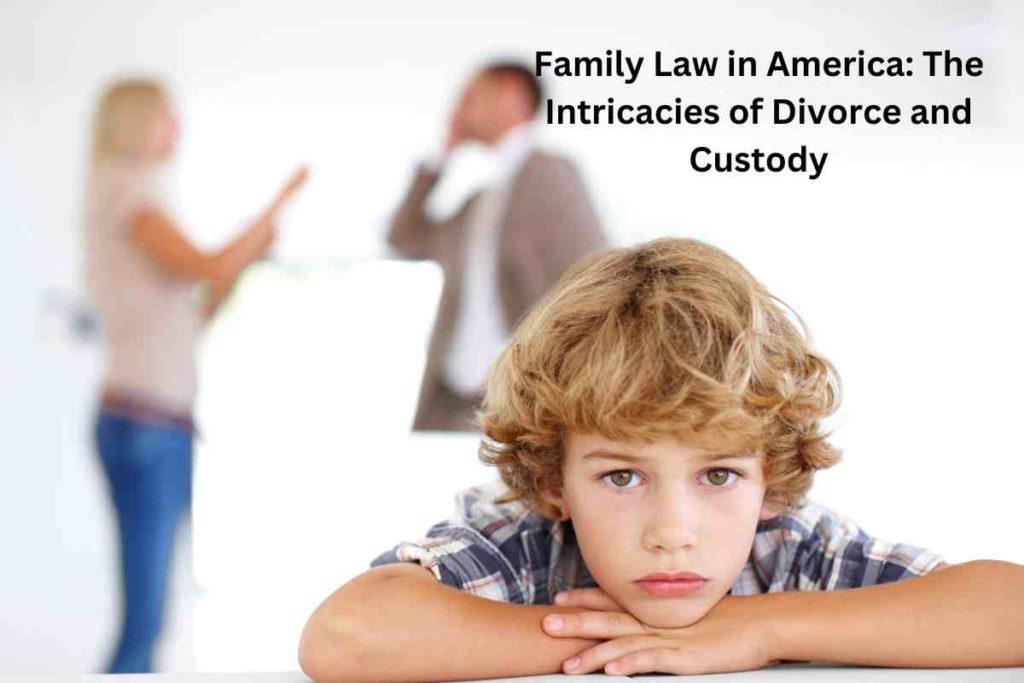Family Law in America: The Intricacies of Divorce and Custody

Family Law in America: The Intricacies of Divorce and Custody:- Family law in America is deeply rooted in ensuring the protection and welfare of all family members during times of upheaval and change. One of the most challenging aspects of family law is navigating the complexities of divorce and custody. Let’s delve into the nuances and intricacies surrounding these topics in the American legal landscape.
Understanding Divorce: The Termination of a Marital Bond
Divorce, also known as the dissolution of marriage, represents the legal end to a marital union, effectively severing the rights and responsibilities of matrimony.
Grounds for Divorce
The U.S. allows both “no-fault” and “fault” divorces:
- No-fault Divorce: Neither spouse needs to demonstrate any reason for the divorce apart from asserting marital differences.
- Fault Divorce: One spouse claims and proves specific reasons such as adultery, abuse, or abandonment.
Distribution of Assets and Liabilities
The approach to dividing marital properties varies:
- Community Property States: Assets and debts amassed during the marriage are jointly owned and split evenly.
- Equitable Distribution States: Assets and debts are divided fairly, which might not always mean equally.
Alimony and Financial Support
Not every divorce results in alimony. Its purpose is to limit any potential financial hardships. Factors like the marriage’s duration, the spouse’s age and health, and financial disparities play a role in determining alimony.
The Delicate Matter of Child Custody
When it comes to child custody, the courts prioritize the child’s best interests above all.
Forms of Custody
- Physical Custody: Refers to with whom the child will live.
- Legal Custody: Pertains to decision-making rights concerning the child’s health, education, and overall well-being.
These types of custody can be singular (awarded to one parent) or joint.
Rights of Visitation
Typically, the non-custodial parent receives visitation rights. Whether structured or open-ended, the specifics often hinge on the child’s best interest and parental cooperation levels.
Custody Modifications
Life is unpredictable, and situations can change. If significant changes occur, custody arrangements can be revisited and adjusted, provided they continue to align with the child’s best interests.
Child Support: Ensuring Children’s Financial Stability
Child support payments are designed to cover a child’s basic needs, from housing and food to education and medical care. Payment calculations consider factors like parental income, the number of children, and the child’s standard of living prior to the divorce.
Also Read Maximizing Work Opportunities in Canada During and After Studies
Emotional Considerations and Support
Beyond the legalities, divorce and custody disputes are emotionally taxing. Counseling and therapeutic services can be invaluable during these trying times, not only for the separated couple but especially for affected children.
Mediation and Collaborative Divorce: Alternatives to Traditional Litigation
Given divorce litigation’s emotional and financial toll, many couples are exploring alternative dispute resolution methods to find more amicable solutions.
The Mediation Process
Mediation involves a neutral third-party mediator who helps the divorcing couple navigate their disagreements and reach mutual decisions without resorting to court battles. This approach:
- Promotes Open Communication: Facilitates a platform for both parties to express their concerns.
- Is Cost-Effective: Generally less expensive than traditional litigation.
- Is Confidential: The details remain private, unlike court proceedings which are public records.
Collaborative Divorce: A Team Approach
In a collaborative divorce, each spouse hires their attorney trained in collaborative law processes. Together, as a team, they work towards reaching a mutual agreement, occasionally involving other professionals like child custody specialists and financial consultants. This method:
- Encourages Cooperative Problem Solving: Focuses on win-win solutions.
- Prioritizes Children’s Well-Being: Places the children’s needs at the forefront.
- Requires Voluntary Transparency: Spouses must openly share all relevant information.
The Role of Prenuptial and Postnuptial Agreements
These agreements can ease the divorce process, primarily when substantial assets are involved.
Prenuptial Agreements
Drafted before marriage, a prenuptial agreement outlines the distribution of assets, debts, and spousal support should the marriage end in divorce. Reasons for considering a prenup include:
- Protection of Separate Assets: Ensures individual assets remain separate.
- Clarification of Financial Rights: Reduces misunderstandings about financial matters.
- Protection from Debts: Shields one spouse from the other’s liabilities.
Postnuptial Agreements
Created after a couple is already married, postnuptial agreements serve a similar purpose to prenups but are often considered when:
- Financial Circumstances Change: E.g., when one spouse receives a significant inheritance.
- To Strengthen the Marriage: Some couples feel a postnup clarifies financial expectations, reducing potential conflicts.
The Impact on Extended Families
Divorces don’t just affect the couple; they ripple through the entire family.
Grandparent Rights
In some instances, grandparents may seek visitation rights, especially if they had a close relationship with the child before the divorce.
Sibling Separations
In rare cases, siblings might end up living with different parents. Maintaining these relationships is crucial for the emotional well-being of the children.
Children and Divorce: Nurturing Resilience
Divorce inevitably brings upheavals, especially for children. Understanding their needs and fostering a supportive environment can be instrumental in their adjustment and overall well-being.
How Children Perceive Divorce
Depending on their age and maturity, children’s perception of divorce varies:
- Toddlers: They might not grasp the concept of divorce but can sense the change in routines and the emotional climate.
- Elementary-aged children: Often believe they’re the cause of the divorce, leading to feelings of guilt.
- Teenagers: While more understanding, they might direct anger towards one or both parents, often masking feelings of vulnerability.
Maintaining Stability
Amid the changes, maintaining routines and familiarities can offer a sense of security. Simple routines, such as bedtime stories or weekend outings, can provide comfort.
Open Communication
Encouraging children to express their feelings and assuring them that their emotions are valid can facilitate healing.
Dating and Remarriage: Venturing Into New Territories
Life after divorce often opens doors to new relationships and the possibility of remarriage.
When to Start Dating Again
There’s no one-size-fits-all answer. It’s essential to ensure you’re moving forward for the right reasons, not merely to fill a void.
Introducing New Partners to Children
Proceed with caution. It’s pivotal to establish a solid relationship foundation before introducing a new partner to your children.
Blended Families and Their Dynamics
Remarriage might lead to blended families, introducing step-siblings and step-parents into the mix. Patience, open communication, and setting clear boundaries are vital for a harmonious blended family environment.
Legal Repercussions: The Importance of Complying with Court Orders
Once divorce decrees and custody arrangements are set, adherence is non-negotiable.
Consequences of Non-compliance
Ignoring court orders, be it visitation rights or alimony payments, can have severe legal repercussions, including fines or jail time.
Modifying Court Orders
Life is fluid, and circumstances change. If changes affect court order adherence, it’s crucial to seek legal modifications promptly.
Post-Divorce Growth: Finding Yourself Again
Divorce, while challenging, can also be a period of self-discovery and growth.
Embracing Solitude
It offers a chance to reflect, understand oneself better, and determine what one truly desires from future relationships.
Seeking Therapy and Counseling
Professional guidance can provide coping strategies and a fresh perspective on moving forward.
Rebuilding and Fostering New Relationships
Life post-divorce is an opportunity to redefine oneself, cultivate new hobbies, and build meaningful relationships.
Financial Adjustments: Managing Money Post-Divorce
One of the profound changes following a divorce is the adjustment to a new financial reality.
Budgeting on a Single Income
After years of dual-income or relying on a partner’s earnings, it can be daunting to manage finances on a single income. Creating a strict budget that factors in all expenses, from necessities to leisure, becomes paramount.
Re-evaluating Financial Goals
Divorce often necessitates a rethinking of long-term financial goals. Whether it’s buying a house, retirement planning, or saving for a child’s education, recalibrating these goals in light of the changed financial situation is essential.
Understanding Alimony and Child Support
For recipients, it’s crucial to budget and ensure these funds are used responsibly. For payers, it’s vital to understand that these are legally mandated, and failure to pay could have serious legal consequences.
Coping Mechanisms: Dealing with Emotional Residue
Divorce can leave emotional scars, and navigating this emotional aftermath is as crucial as handling legal or financial implications.
Finding Support Groups
Joining a support group can offer solace. Sharing experiences and coping mechanisms with those in similar situations can provide invaluable emotional support.
The Role of Friends and Family
Never underestimate the power of a supportive network. Friends and family can provide a listening ear, a comforting shoulder, or even practical assistance as you rebuild your life.
Engaging in Activities
Distracting the mind can be therapeutic. Picking up new hobbies, traveling, or just indulging in activities that bring joy can aid in the healing process.
The Silver Lining: Discovering Strength in Adversity
While divorce is undeniably challenging, it also presents an opportunity for personal growth and self-improvement.
Embracing Personal Growth
Post-divorce is a chance to introspect and understand oneself better. Many find strength and resilience they didn’t know they had, leading to profound personal growth.
Empowerment Through Independence
Being solely responsible for decisions can be empowering. Whether it’s making financial choices, raising children, or simply deciding the course of one’s life, this newfound independence can be incredibly liberating.
Looking to the Future
While the past cannot be changed, the future remains a blank slate. It’s essential to focus on the potential of what lies ahead rather than remaining anchored to past hurts.
Conclusion
The journey through divorce and custody intricacies is undoubtedly tumultuous. Yet, with resilience, support, and understanding, it’s possible to emerge stronger, with renewed hope and a clearer vision of the future. Every ending is a new beginning, and with the right mindset and tools, one can navigate the complexities of family law in America and carve out a path of healing and growth. Family law, especially concerning divorce and custody in America, is multifaceted, with numerous emotional, financial, and legal intricacies. However, equipped with the right knowledge, resources, and support, individuals can navigate these complexities with grace and resilience. The end of a marital chapter can be the beginning of a personal renaissance, filled with growth, discovery, and hope. Life’s trials often pave the way for its most profound triumphs.






